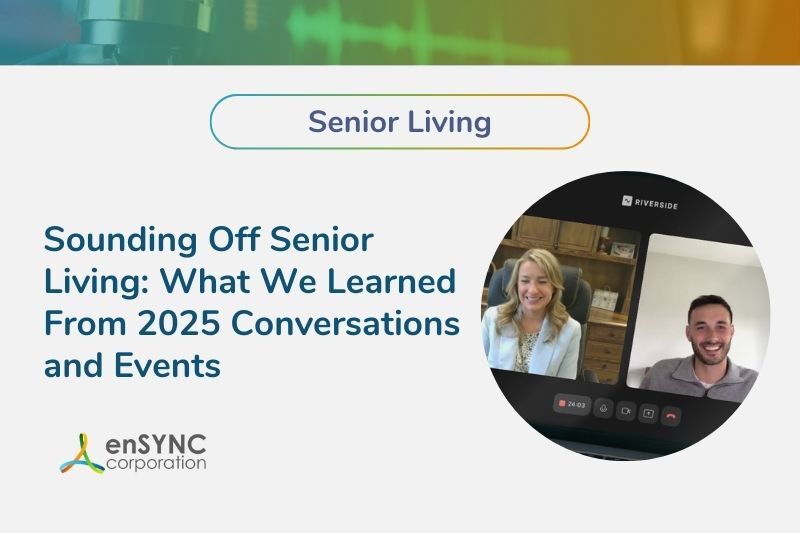Technology & digital transformation | Strategy & planning | Senior living
Setting Strategic Goals to Improve Senior Living Organization Performance
June 4, 2024
|
Balancing the books is essential for a thriving senior living community, but it's the broader strategic goals that truly enhance the experience for residents and staff alike. These goals are pivotal in creating exceptional care and forging strong community connections. Once your strategic goals are established, you can better assess key performance indicators (KPIs) with your financial reporting software.
Why Setting Strategic Goals Is Important in Senior Living Care
Strategic goals serve as the blueprint for tracking progress and innovation at your senior living organization. They also represent your organization's commitment to elevating every aspect of community life. Here’s the impact of well-defined goals:
- They establish high standards in caregiving, improving the quality of service.
- They boost the spirits of residents, creating a lively and fulfilling atmosphere.
- They lay a solid foundation for financial well-being, reinvesting in the community.
- They nurture a feeling of unity, aligning everyone with the community’s core mission and values.
4 Simple Steps to Start Setting Strategic Goals in Your Organization
To set strategic goals for a senior living organization, you can follow these simple steps:
- Identify Key Objectives: Begin with a clear understanding of what you want to achieve, such as improving care quality or enhancing resident engagement.
- Assess Current Standing: Evaluate where your organization currently stands in relation to these objectives to identify areas for improving senior living organization performance.
- Plan With Precision: Develop detailed action plans for each goal, outlining the steps necessary to move from where you are to where you want to be.
- Monitor Progress: Set up mechanisms to regularly track progress against each goal, adjusting tactics as needed to stay on course.
By following these steps, you’ll establish a clear roadmap for your organization’s growth and overall strategic vision.
How to Make Strategic Goals Part of Your Mission
Incorporating strategic goals into the daily rhythm of your senior living organization’s mission involves three key steps:
- Align Goals With Mission: Ensure every goal contributes to your long-term vision and resonates with the community's values and purpose.
- Engage Staff in Goals: Foster a sense of collective ownership over the strategic plan. Achieving goals requires the hands-on involvement of every team member.
- Feedback Loops: Establish regular checkpoints for feedback, keeping strategies aligned with daily operations and enhancing the resident experience.
By embracing these steps, strategic goals become integral to your community's mission, guiding daily operations and decisions.
5 Examples of Strategic Goals to Improve Senior Living Organization Performance
Now that we’ve reviewed how setting strategic goals can positively impact your organization, let’s explore some essential targets that can drive success and support senior living missions.
Goal: Enhance Resident Satisfaction
Why It’s Important: Happy residents are the heart of your community. Setting goals to update amenities and services not only improves their daily living experience but also boosts your reputation, encouraging new admissions and long-term loyalty.
Example KPIs:
- Resident net promoter score (NPS).
- Frequency of resident participation in activities.
Goal: Boost Occupancy Rates
Why It’s Important: Keeping your community full means resident fees stay manageable, ensuring both your staff and operations can thrive. Attracting new residents and minimizing empty rooms stabilizes your finances, keeping everything running smoothly.
Example KPIs:
- Inquiry to move-in conversion rate.
- Occupancy rate trends month-over-month.
Goal: Improve Care Quality
Why It’s Important: Quality care is what draws families to your doors. Investing in your team’s training means top-notch services for residents, which is essential for their well-being and your community's standing.
Example KPIs:
- Health inspection scores.
- Resident satisfaction survey results.
- Staff-to-resident ratio in care.
Goal: Strengthen Community Relationships
Why It’s Important: Strong ties to the local area bring a sense of belonging. Partnering with local businesses and hosting events can turn neighbors into friends and advocates for your community.
Example KPIs:
- Number of community partnerships.
- Attendance at community events.
- Community volunteer hours.
Goal: Expand Services
Why It’s Iimportant: Catering to a broad range of needs means no resident gets left behind. Expanding services ensures you provide comprehensive care, which is key to resident satisfaction and retention.
Example KPIs:
- New services adoption rate.
- Utilization rate of expanded services.
- Resident feedback on new services.
Strategic goals are the steppingstones to a thriving senior living community. Start setting strategic goals to reach your organization's mission and, more importantly, create a bright future for your residents and team.
Are Your Strategic and Financial Goals Working Together?
Ready to ensure your financial and strategic goals are in sync for the long haul? Our team specializes in financial tech and senior living strategies. Let's make tracking and achieving your goals seamless. Connect with our experts to learn more!

Chadd Arthur is a seasoned professional with over 25 years of experience in the non-profit sector, specializing in process improvement and the strategic alignment of organizational goals with technology solutions. Leveraging his extensive expertise, Chadd conducts regular strategic assessments for organizations, guiding them towards enhanced efficiency and effectiveness. With a profound passion for aiding clients in recognizing the value of process improvement, Chadd leads our team in secure technology solutions that directly contribute to their mission success. His commitment to excellence is evident in his contributions to the industry, including participating in panels and serving as a thought leader to a network of non-profit professionals. Chadd earned his MBA from Indiana University Bloomington and resides outside the greater Chicago area. Chadd not only brings a wealth of knowledge and experience but also a dedication to making a meaningful impact in the non-profit space.
Recent Posts

5 Trends Set to Shape Association Management in 2026
As 2026 begins, associations are standing at the edge of some major shifts. Member expectations are changing, technology keeps opening new...

The Best of the Blog 2025 — A Year in Review
From forward-looking trend analyses to powerful case studies and thought-provoking conversations, the enSYNC blog featured a host of great content in...
Enjoying our blog?
At enSYNC, we want to empower associations and nonprofits to make well-educated decisions. If you want our industry knowledge (and other free guides) sent directly to your inbox, fill out the form below.


